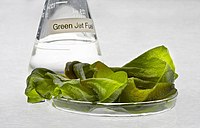
Photo from wikipedia
Microalgal biomass has been considered a potential source of lipids, proteins, and carbohydrates for different industrial applications. Usually, molecules with a possibility of use in food, pharmaceutical, and cosmetic industry… Click to show full abstract
Microalgal biomass has been considered a potential source of lipids, proteins, and carbohydrates for different industrial applications. Usually, molecules with a possibility of use in food, pharmaceutical, and cosmetic industry are added-value products that can make microalgae large-scale production economically viable. Examples of molecules present in microalgae biomass are triglycerides rich in Polyunsaturated Fatty Acids (PUFAs) widely studied due to the benefits to human health, including prevention of cardiovascular diseases and diabetes. Some marine microalgae such as Isochrysis sp., Nannochloropsis sp. and diatom Phaeodactylum tricornutum are known to exhibit high quantities of long-chain PUFA such as Eicosapentaenoic Acid (EPA) and Docosahexaenoic Acid (DHA). In addition, some species show a high content of Monounsaturated Fatty Acids (MUFAs) on lipids, as Botryococcus braunii, which usually contains more than 50% of oleic acid. Other high-value molecules from microalgae biomass are the anti-oxidants and vitamin precursors named carotenoids, such as s-carotene, fucoxanthin, and astaxanthin. Besides lipid material, algal proteins can be used in nutrition depending on amino acid profile, as well as a source of high-value peptides. Also, polysaccharides are used as food additives as they exhibit anti-oxidant properties. This short review focused on the screening of different microalgae species to produce high-value lipids, aiming long-chain fatty acids production of industrial interest. Some aspects are considered in this work, such as biomass productivity and composition together with information on cultivation conditions. Therefore, it may help researchers and process engineers to select the adequate microalgae strain for application in large-scale plants in the food and pharmaceutical industry.
Journal Title: Chemical engineering transactions
Year Published: 2019
Link to full text (if available)
Share on Social Media: Sign Up to like & get
recommendations!